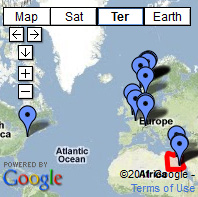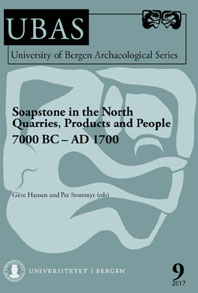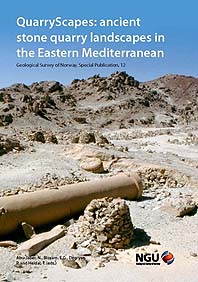Search this site
Welcome!
I work with the geoarchaeology of old stone: quarries, monuments, rock art. And I try to figure out about their weathering, and conservation using traditional crafts. I also burn lime the traditional way. My domestic services are managed through FABRICA, a registered Norwegian company established with good partners. On this website I publish articles on many aspects of cultural heritage. For the joy of old stone! Per Storemyr
Visit FABRICA’s website!

-
-
Recent posts
- Tradisjonell kalkbrenning i små, vedfyrte ovner. Erfaringer fra 6 brenninger i Tvedestrand
- Vinterbrenning av Brevikkalk. Med beskrivelse av kalkens geologi og egenskaper
- Middelalderkirker i stein: Hva mikroskopanalyse av kalkmørtler kan fortelle om historie, skader og mørtelvalg for restaurering
- Norwegian medieval lime mortars under the microscope
- Småskala kalkbrenning. Geologisk mangfold i kulturminnevernets tjeneste
Popular right now
Find posts by Google Maps

Follow on:

Follow on Facebook
SOAPSTONE! New book on its archaeology and history!

Book: The Stones of Nidaros Cathedral

Book: QuarryScapes

Get informed! State of the Art on natural stone today:

Tag Archives: Norway
Rock art and red-coated bedrock in Alta, Arctic Norway
Over the past few years Karin Tansem of the Alta World Heritage Rock Art Centre and I have investigated the hypothesis that the famous rock engravings in Alta originally was made on strongly red-coloured bedrock along the seashore. The post-glacial land uplift has subsequently displaced the rock art and the colour has almost completely waned, leaving the rocks dull grey, as we know them today. Now we are happy that our work is finally published as an open-access paper, with Karin as driving force and lead author, in the international journal Geoarchaeology! Here’s the abstract explaining the phenomenon and its implications, and a link to the full paper. Continue reading
Posted in New publications, Norway, Rock art
Tagged aesthetics, Alta, Alta rock art, Norway, red colour, rock art, sandstone, UNESCO World Heritage, weathering
1 Comment
Happy New Year to clients, partners and followers! With photos from work and excursions in 2018
I wish clients, partners and followers of my website a Happy and Prosperous New Year! I am glad for the trust you have shown my little company and me in 2018. And I look forward to aid in conservation and archaeological work at monuments, old stone quarries and rock art sites in 2019. Below is a gallery of photos from some of the sites I worked at and visited on excursions last year. Also, a list of reports, publications and web-articles finalised in 2018 is attached. They give a glimpse of activities, many of which will continue. See you in the new year! Continue reading
Posted in Monument conservation, New projects, New publications, New reports, Norway, Old quarries, Rock art
Tagged conservation, Italy, Norway, Romania
1 Comment
The limekiln at Hyllestad, Western Norway: Rebuilding a new, “historic” kiln for burning lime
Last year we built a limekiln at Millstone Park in Hyllestad, Western Norway, reported on this website. The kiln was built in a traditional fashion, following Roman and Medieval principles. Experimental archaeology! After one burn, which gave excellent quicklime, the kiln was, unfortunately, badly damaged. Cracks in the masonry! So we had to rebuild the kiln to be able to produce more quicklime! Over the last few months a team of professional, Norwegian masons and local volunteers, 15 people altogether, has undertaken the task: Just a little more work to be done, and soon we’ll have two(!) limekilns, one big and one small – for producing “historic” quicklime in the years to come. For restoring old stone buildings.
Below, you will find a report of the rebuilding, written in Norwegian. Use Google Translate if you are not familiar with the language. The report is written by me and was first published on the website of Millstone Park (kvernsteinsparken.no) a couple of days ago. I work part-time as an Associate Professor for Millstone Park and I am project leader and responsible for building, rebuilding and running the limekiln. Great combination of craft and theory, experimental archaeology! But I’m also involved, privately and through my company, Archaeology & Conservation Services, as a local volunteer. Building and running a historic limekiln is a very big task, many months of work for many people! And though the Norwegian Directorate for Cultural Heritage is a generous sponsor of the project, voluntary work is indispensable. Thank you all! And here’s the report, with many videos and photos: Continue reading
Posted in Archaeology, Marble, New projects, Norway
Tagged Hyllestad, Kvernsteinsparken, limekiln, marble, Norway
3 Comments
Taken by the frost! The beauty and destructive force of ice growth on masonry
After 29 years of working with weathering of cultural heritage, I have finally seen it “live”: How the force of ice can destroy plaster on stonework. It is more diverse than I though. A complex and fascinating world of beautiful … Continue reading
Posted in Heritage destruction, Monument conservation, Norway
Tagged frost heaving, frost weathering, Hyllestad, lime mortar, limekiln, Norway, salt weathering, weathering
3 Comments
The world’s northernmost medieval marble church
The small, Romanesque Gildeskål church is one of the most complete marble churches in Norway. It resides at the magnificent coast along the Atlantic Ocean far up north, in Nordland county. And it is, presumably, the northernmost marble building in the world. Together with Giske church further south, it is part of outstanding, but little known, medieval marble architecture in Norway, of which Nidaros Cathedral, with thousands of marble columns, is the most spectacular example. Continue reading
Posted in Archaeology, Marble, New publications, Norway, Old quarries
Tagged Cultural heritage, Gildeskål, marble, Middle Ages, North Atlantic, Norway, old quarries, quarry
Leave a comment
Værnes: Norges mest komplette sandsteinskirke fra middelalderen
Den er dekorert med elementer av kleberstein og klorittskifer, men ellers er det sandstein så langt øyet kan se: Værnes er Norges mest komplette sandsteinskirke fra middelalderen! Den rager i størrelse og volum av brukt sandstein langt over middelalderbyggverk i tilsvarende stein i andre deler av landet! Her er et sammendrag av min artikkel til boken «Værnes kirke – en kulturskatt i stein og tre» som ble utgitt for et par uker siden (november 2016). Det er Grubleseminaret som står bak, med Morten Stige og Kjell Erik Pettersson som fantastiske redaktører av boken! Continue reading
Posted in Archaeology, New publications, Norway, Old quarries
Tagged chlorite schist, Norway, quarry, sandstone, soapstone, Værnes kirke
1 Comment
Tusen år med brytning av kleberstein tok nettopp slutt. En historie om mekanisering og globalisering. Og om å gjenoppdage gammelt håndverk
Det er ytterst vanskelig å skaffe kleberstein til restaurering av Norges middelalderkirker. Til og med avisene har fått det med seg. Ved Nidarosdomen, Stavanger domkirke og i Bergen klør man seg i hodet: Det finnes ingen kleberbrudd i drift i Norge! De har blitt offer for globalisering. Hva er redningen? Kan man lære av hvordan kleberstein ble tatt ut manuelt i gamle dager? Kan man låne kunnskap fra et tilgrensende fagområde, nemlig bruk av kalkmørtel? De gamle bygningene trenger også sårt til god kalkmørtel! Problemet har vært at kunnskap om gammel kalkproduksjon har lagt nede i mer enn 50 år. Men nå produseres det brent kalk som aldri før i små «middelalderovner». Håndverket har blitt aktivt vekket til live gjennom eksperimentell virksomhet. Støttet av kulturminnevernet. Kan vi også vekke det gamle steinbryterhåndverket til live igjen? Til glede for restaurering? Continue reading
New open-access book: Soapstone in the North. Quarries, Products and People. 7000 BC – AD 1700
NEW BOOK: Hansen, G. & Storemyr, P. (eds.) 2017. Soapstone in the North: Quarries, Products and People. 7000 BC – AD 1700. UBAS University of Bergen Archaeological Series, 9, 408 p. Abstract: “Soapstone is a remarkable rock. While it is soft and very workable, it is also durable and heat-resistant, and with a high heat-storage capacity. These properties have been recognised and valued around the world since prehistoric times, and soapstone has been used for a multitude of purposes, ranging from everyday household utensils to prestigious monuments and buildings. This book addresses soapstone use in Norway and the North Atlantic region, including Greenland. Although the majority of the papers deal with the Iron Age and Middle Ages, the book spans the Mesolithic to the early modern era. It deals with themes related to quarries, products and associated people and institutions in a broad context. Recent years have seen a revival of basic archaeological and geological research into the procurement and use of stone resources. With its authors drawn from the fields of archaeology, geosciences and traditional crafts, the anthology reflects cross-disciplinary work born of this revival.” Continue reading
Posted in Archaeology, New publications, Norway, Old quarries
Tagged artefacts, Greenland, Iron Age, Kleberstein, Mesolithic, Middle Ages, North Atlantic, Norway, old quarries, provenance, soapstone
3 Comments
Forvitring av kleberstein på middelalderkirker – to videoer
Sist vinter holdt jeg to foredrag om forvitring av kleberstein sett i lys av bygnings- og restaureringshistorie. Det dreide seg om portaler fra norsk middelalder og foredragene ble holdt på «Portalseminaret» i regi av «Domkirken 2025»; miljøet som nå restaurerer Stavanger domkirke og som jeg også er en liten del av. Alle foredragene fra seminaret (og mange andre interessante saker om restaureringen) er nå lagt ut på YouTube.
Kanskje kan mine to foredrag være til hjelp for folk som sliter med å forstå hvorfor kleberstein forvitrer. Veldig mye dreier seg om hva bygningene har vært utsatt for av forandringer og restaureringer gjennom tidene. Men noe av forvitringen kan også knyttes til steinkvalitet, tidligere luftforurensning og ikke minst vann! Rett og slett lekkasjer! Innholdet i foredragene er i stor grad basert på min gamle doktoravhandling “The Stones of Nidaros” fra 1997 og mange artikler om forvitringshistorie, bl.a. “Weathering of soapstone in a historical perspective”. Continue reading
Posted in Monument conservation, New publications, Norway, Weathering history
Tagged conservation, historic photos, Kleberstein, Norway, soapstone, weathering
Leave a comment

